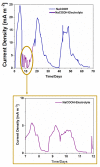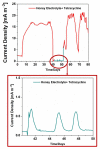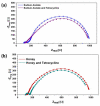Microbial Fuel Cells as Effective Tools for Energy Recovery and Antibiotic Detection in Water and Food
- PMID: 38138306
- PMCID: PMC10745599
- DOI: 10.3390/mi14122137
Microbial Fuel Cells as Effective Tools for Energy Recovery and Antibiotic Detection in Water and Food
Abstract
This work demonstrates that microbial fuel cells (MFCs), optimized for energy recovery, can be used as an effective tool to detect antibiotics in water-based environments. In MFCs, electroactive biofilms function as biocatalysts by converting the chemical energy of organic matter, which serves as the fuel, into electrical energy. The efficiency of the conversion process can be significantly affected by the presence of contaminants that act as toxicants to the biofilm. The present work demonstrates that MFCs can successfully detect antibiotic residues in water and water-based electrolytes containing complex carbon sources that may be associated with the food industry. Specifically, honey was selected as a model fuel to test the effectiveness of MFCs in detecting antibiotic contamination, and tetracycline was used as a reference antibiotic within this study. The results show that MFCs not only efficiently detect the presence of tetracycline in both acetate and honey-based electrolytes but also recover the same performance after each exposure cycle, proving to be a very robust and reliable technology for both biosensing and energy recovery.
Keywords: antibiotic contamination; bio-electrochemical sensors; biosensors; energy recovery; microbial fuel cells.
Conflict of interest statement
The authors declare no conflict of interest.
Figures





Similar articles
-
Effect of the tetracycline antibiotics on performance and microbial community of microbial fuel cell.Bioprocess Biosyst Eng. 2021 Mar;44(3):595-605. doi: 10.1007/s00449-020-02473-8. Epub 2020 Nov 12. Bioprocess Biosyst Eng. 2021. PMID: 33180189
-
Electrospun Nanofibers: from Food to Energy by Engineered Electrodes in Microbial Fuel Cells.Nanomaterials (Basel). 2020 Mar 14;10(3):523. doi: 10.3390/nano10030523. Nanomaterials (Basel). 2020. PMID: 32183252 Free PMC article.
-
A comprehensive overview on electro-active biofilms, role of exo-electrogens and their microbial niches in microbial fuel cells (MFCs).Chemosphere. 2017 Jul;178:534-547. doi: 10.1016/j.chemosphere.2017.03.066. Epub 2017 Mar 27. Chemosphere. 2017. PMID: 28351012 Review.
-
Anode Surface Bioaugmentation Enhances Deterministic Biofilm Assembly in Microbial Fuel Cells.mBio. 2021 Mar 2;12(2):e03629-20. doi: 10.1128/mBio.03629-20. mBio. 2021. PMID: 33653887 Free PMC article.
-
Microbial fuel cells for waste nutrients minimization: Recent process technologies and inputs of electrochemical active microbial system.Microbiol Res. 2022 Dec;265:127216. doi: 10.1016/j.micres.2022.127216. Epub 2022 Sep 30. Microbiol Res. 2022. PMID: 36202006 Review.
Cited by
-
(Bio)Electroanalysis of Tetracyclines: Recent Developments.Biosensors (Basel). 2025 Feb 11;15(2):101. doi: 10.3390/bios15020101. Biosensors (Basel). 2025. PMID: 39997003 Free PMC article. Review.
References
-
- Wu D., Du D., Lin Y. Recent progress on nanomaterial-based biosensors for veterinary drug residues in animal-derived food. Trends Anal. Chem. 2016;83:95–101. doi: 10.1016/j.trac.2016.08.006. - DOI
-
- Veterinary Drug Residues in Animal and Food: Compliance with Safety Levels Still High. [(accessed on 26 September 2023)]. Available online: https://www.efsa.europa.eu/en/news/veterinary-drug-residues-animals-and-....
LinkOut - more resources
Full Text Sources

